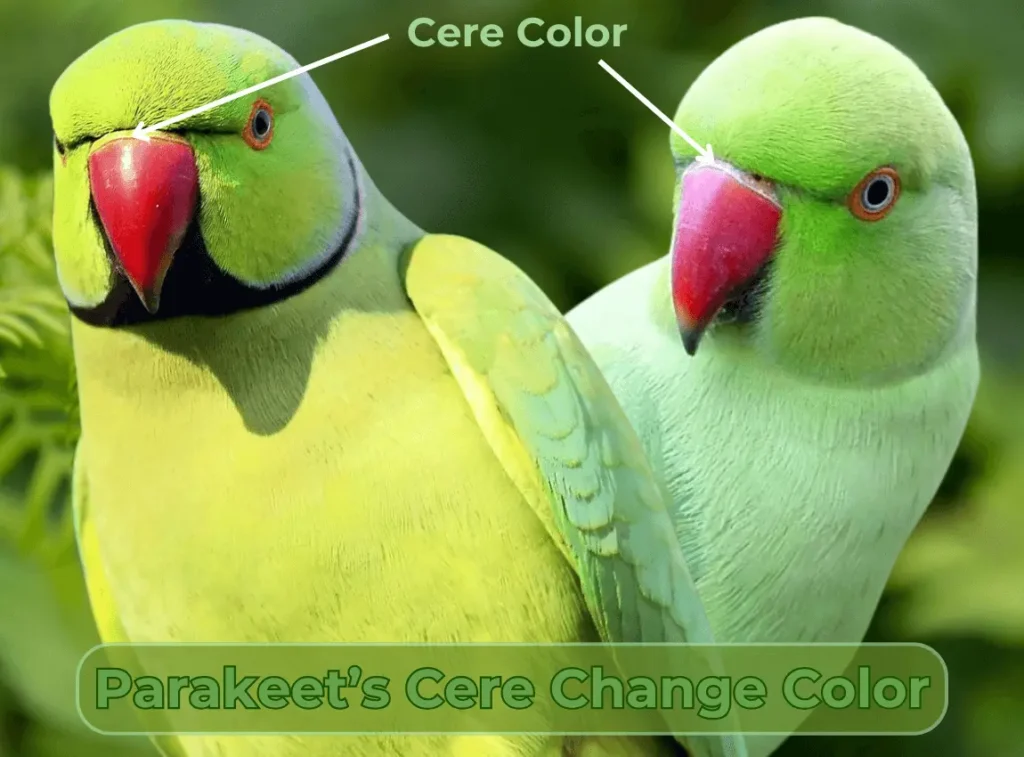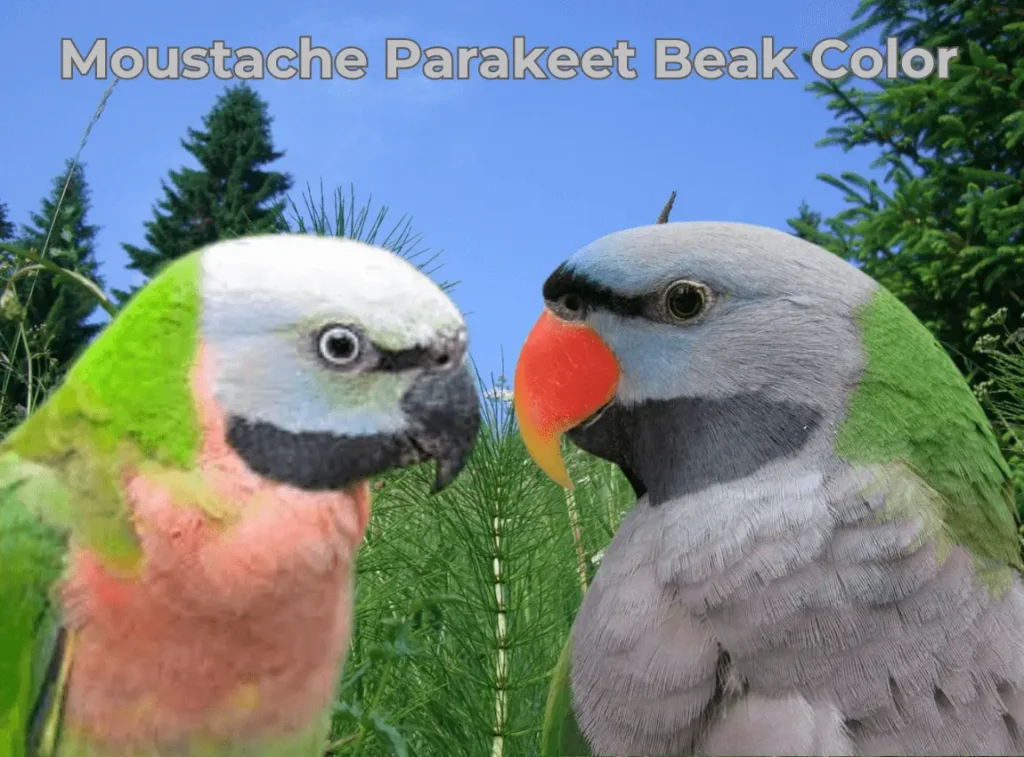Parakeets are charming and colorful birds loved for their cheerful nature and sociable personality. The small fleshy area above the beak that houses the nostrils known as cere is a key feature of their charm. The cere not only plays an important role in breathing but is also an indicator of sex, age and health. One of the most interesting features of the parakeet brain is that it can change color at different stages of life and in certain situations.

In this article, we will look at why and when your parakeet cere change color brain. what parakeet cere change color mean, and how you can use this information to better experience understand and care for your feathered friend.
- What Is a Cere:
- When Does a Parakeet Cere Change Color:
- Why Does a Parakeet’s Cere Change Color:
- How to Determine the Sex of a Parakeet by Cere Color:
- Moustache Parakeet Beak Color Change:
- Why Does a Moustache Parakeet’s Beak Change Color:
- How to Care for Your Moustache Parakeet’s Beak:
- Identification of Male and Female Moustache Parakeet Beaks:
- Factors That Influence Cere Color Changes:
- Caring for Your Parakeet’s Cere:
- Conclusion:
- Frequently Asked Question:
What Is a Cere:

The wax is the soft waxy fabric on the beak of a common sandpiper. This area contains the bird’s nostrils which parakeet cere change color depending on a variety of factors including age, sex, hormonal changes, and health. Observing a budgie’s brain is one of the easiest ways to determine the bird’s sex and general health an important trait for enthusiasts and breeders.
When Does a Parakeet Cere Change Color:
During Growth and Development:
As parakeets grow the parakeet cere change color of the top of the head changes as they transition from juveniles to adults. This color change is mainly due to hormonal in parakeet cere change color that occur as the bird matures.
- The color of a young parakeet’s head: When parakeets are born the color of their fur is usually pale and indistinct. As the parakeet grows the scalp often takes on a neutral color such as light pink, white or light blue. This color does not indicate the sex of the bird and is the same for both males and females.
- Adult brain color: When a parakeet reaches sexual maturity usually around four to six months of age in parakeet cere change color undergoes a marked change. At this stage the parakeet cere change color of the brain to reflect the bird’s sex.
- Males: The brains of male parakeets usually turn bright blue or purplish blue.
- Females: the brains of female parakeets usually turn brown, beige, white or tan, depending on hormonal activity.
Breeding Season:
The plumage color of adult birds can also change during the breeding season due to fluctuating hormone levels. These changes are more pronounced in female parakeets.
- In females: during the breeding season female budgerigars often become darker and thicker with a brown or crusty texture. This parakeet cere change color is a natural response to rising estrogen levels and signals that it is time to breed.
- In Male: Male budgerigars usually remain bright blue throughout the year but may turn bluer during the breeding season.
Hormonal Changes:
In parakeets environmental factors, stress or age can lead to hormonal changes which can cause temporary changes in the color of the grain. For example in females, if hormone levels fluctuate due to feeding, lighting or health issues the color of the grain may change outside the breeding season.
- Health Conditions: A parakeet cere change color in finger color can sometimes indicate underlying health problems. It is important to regularly monitor your parakeet’s mouth color to detect any problems early.
- Brown or crusted grains in males: While brown crusty grains are normal in females during the breeding season and in males this can indicate a hormonal imbalance or a disease such as a testicular tumor.
- Pale or discolored males: Pale, discolored or discolored grains in both sexes can be a sign of malnutrition, stress or systemic disease. In this case a visit to an avian veterinarian is recommended.
- Swollen or inflamed grains: Swelling, redness or discharge from the grains may indicate an infection such as sinusitis or a fungal infection. In such cases urgent veterinary attention is essential.
- White or scaly brain: White, scaly skin on the cerebellum can be caused by mites especially scaly face mites which should be treated by a veterinarian.
Why Does a Parakeet’s Cere Change Color:
Changes in the croup color of wavy parakeets are caused by certain biological and environmental factors:

Hormonal Activity:
Hormones play an important role in croup color variation especially during the breeding season. In both male and female wavy parakeets hormone levels fluctuate throughout the year especially depending on light cycles. These hormonal changes result in a darkened or more pronounced croup texture.
Sex Differentiation:
As mentioned above one of the most reliable ways to determine the sex of a wavy parakeet is through its cere especially when it reaches maturity. Males have a bright blue head color while females have a tan or brown color that often parakeet cere change color depending on breeding cycles.
Health and Nutrition:
The color and condition of a wavy parakeet’s croup is also indicative of its overall health. A balanced diet rich in vitamins and minerals will keep your wavy parakeet’s grits healthy and bright. In contrast, a deficiency or disease can result in alterations to color and texture.
Age:
The wax of older wavy parakeets may appear duller or have small wrinkles or spots. While this is usually a natural part of aging so significant changes should be watched for.
How to Determine the Sex of a Parakeet by Cere Color:
One of the easiest and most reliable ways to determine the sex of a parakeet is by the color of its fur but this method is only accurate if the parrot is sexually mature (between 4 and 6 months old).
- Males: Male parakeets usually have light blue earlobes. Some color mutations such as albino parakeets, lutino parakeets or red-rumped parakeets, may have pink or purple earlobes instead of blue.
- Females: Female parakeets have white or light brown earlobes. During the breeding season their feathers may become darker and stiffer.
- Hatchlings: Birds are more difficult to identify by the color of their brains as they are usually light and neutral so accurate identification is only possible when they are sexually mature.
Moustache Parakeet Beak Color Change:

Named for their distinctive whiskers moustached parakeets are fascinating birds with unique features including a colorful beak. If you notice that your moustached parakeet’s beak has changed color you’ll want to find out if this is natural or a cause for concern. We will look at why and when the color of a moustached parakeet’s beak changes what it means and how to care for it.
Why Does a Moustache Parakeet’s Beak Change Color:
Beak coloration in bearded parakeets is usually natural and related to specific factors such as age, diet, health, and environmental conditions. Here are the some key reasons for this phenomenon:
Age and Maturity:
The beak of young mustached parakeets is often dull or pale usually light orange or yellow. As they grow the beak turns bright red or dark orange. This change usually occurs when the parakeet becomes sexually mature at 12-18 months of age.
Diet and Nutrition:
The color of your parakeet’s beak reflects its overall health and diet. A lack of key nutrients such as vitamins A and E, can cause the beak to lighten or change color. A balanced diet with seeds, fruits, vegetables, and pellets will help maintain a bright beak color.
Seasonal Hormonal Changes:
During the breeding season some birds may have a slight change in beak color due to hormonal changes. This is more common in adult birds and is usually a temporary phenomenon.
Health Issues:
Unusual or sudden changes in beak color can indicate underlying health problems. For instance:
- Darkened or blackened areas: may suggest bruising or trauma.
- Faded or pale beaks: might indicate malnutrition or illness.
- White spots or crustiness: could signal fungal infections or scaly face mites.
If you notice unusual changes in your parakeet’s beak color so consult an avian veterinarian promptly.
How to Care for Your Moustache Parakeet’s Beak:
- Provide a Nutritious Diet: Offer a diet rich in fruits, vegetables, and high-quality bird pellets to ensure the bird gets the nutrients necessary for beak health.
- Ensure Proper Grooming: Provide cuttlebones or mineral blocks in their cage to help them naturally trim and maintain their beak.
- Monitor for Abnormalities: Monitor your parakeet’s beak for any indication of discoloration, overgrowth, or damage. Preventing serious health problems early can help to identify any potential issues that may pose a risk.
Identification of Male and Female Moustache Parakeet Beaks:
The beak of the Moustached Parakeet is one of the most prominent physical characteristics that can be used to determine the bird’s sex especially as an adult. Although the beaks of young males and females are equally pale the differences become apparent as they mature.

Male Moustache Parakeet Beak:
Adult male mustached parakeets develop a bright red beak that is conspicuous and eye-catching. The red color is eye-catching and serves as a visual signal to distinguish males from females. The red color becomes stronger as the bird gets older, making it easier to identify males between 12 and 18 months of age.
Female Moustache Parakeet Beak:
On the other hand the beak of female parakeets with mustaches turns a dull orange-red or dull red color as they mature. This color is significantly less pronounced than in males and often appears duller.
Juvenile Beak:
In young parakeets the beaks of both males and females are pale orange or yellowish making it difficult to determine sex before maturity. By observing the intensity of beak color parakeet owners can confidently determine the sex of their bird. However, in cases where the beak color is unclear then it may be necessary to consult a parakeet expert or DNA testing to accurately identify the parakeet.
Factors That Influence Cere Color Changes:
The parakeet’s grain color and texture are influenced by many factors including the presence or absence of feathers.
- Diet: A balanced diet rich in vitamins and minerals promotes overall health including the grain. Malnutrition can lead to discoloration or abnormal texture of the grain.
- Lighting: Adequate exposure to natural or semi-natural light can affect the hormonal health of your parakeet and the color of the grain.
- Age: With age, the color of the grain may fade or lose vibrancy. This is a natural component of the ageing process in parakeet.
- Breeding conditions: During the breeding season hormonal fluctuations can cause temporary changes in the color and texture of the grain.
Caring for Your Parakeet’s Cere:
Parakeet seeds need proper care and regular monitoring to stay healthy. Here are some tips:
- Regular monitoring: check your parakeet’s brain weekly for any changes in color, texture or size.
- Maintain a balanced diet: Give your parakeet seeds, fresh fruit, vegetables and pellets to get the nutrients it needs.
- Provide adequate lighting: To maintain hormone balance give the bird natural sunlight or use full spectrum lighting.
- Keep the cage clean: Clean the cage regularly to prevent infections that can affect the bird’s respiratory system and the health of the grain.
- Veterinary visits: Visit your veterinarian regularly to ensure the overall health of your parakeet and to quickly resolve any problems.
Also Read: https://thepetlive.com/can-parakeets-see-color/
Conclusion:
The parakeet brain is not only a functional anatomical region, but also a window into its age, sex, health and hormonal status. As parakeets develop from juveniles to adults and during the breeding season there are natural changes in brain color. These changes are usually normal but can sometimes be signs of health problems and should be noted.
By observing your parakeet’s grain and understanding the consequences of these changes you can look after your feathered friend and keep them happy and healthy. Whether you’re trying to determine your parakeet’s sex or monitor its health. Its brain can provide you with valuable information about its unique and fascinating life.
The beak of whiskered parakeets naturally changes color with age and maturity often turning bright red or orange as an adult bird. However, nutritional and hormonal changes as well as health issues can affect beak color. With proper care and by monitoring the bird’s health it is possible to ensure that the beak remains healthy and colorful throughout life.
Frequently Asked Question:
Is it normal for a parakeet’s cere to change color suddenly?
While gradual changes during development or breeding are normal sudden changes may indicate health problems and should be assessed by a veterinarian.
Can a female parakeet’s cere stay blue?
In rare cases female parakeets may retain blue eyes due to hormonal imbalances or certain health conditions but this is not common.
How long does it take for a juvenile parakeet’s cere to change?
The transition usually occurs between the 3rd and 6th month of life when sexual maturity is approaching.
At what age do budgies’ ceres change color?
Parakeet brain tissue changes color between the 3rd and 6th month of life usually when they reach sexual maturity. Males develop a blue brain coloration and females a brown, white or brownish coloration.
What gender is a parakeet with a purple cere?
Parakeets with purple brains are probably young males. This is because the brains of young males are often reddish-purple before turning blue as adults.
Do parakeet beaks change color?
Yes, the beaks of parakeets can change color especially during growth and maturation. For example, the beaks of young birds are lighter in color and become lighter as they grow.
Do parakeets change color with age?
The color of parakeets’ bodies does not change significantly with age. However, subtle changes in the lightness of the feathers, the brain and the beak may occur with age.
What color are male and female parakeets’ beaks?
Male cockatoos have bright and smooth beaks like light blue cerise while female cockatoos’ beaks are often blurred and may appear brown, beige or even a little rough during the breeding season.










